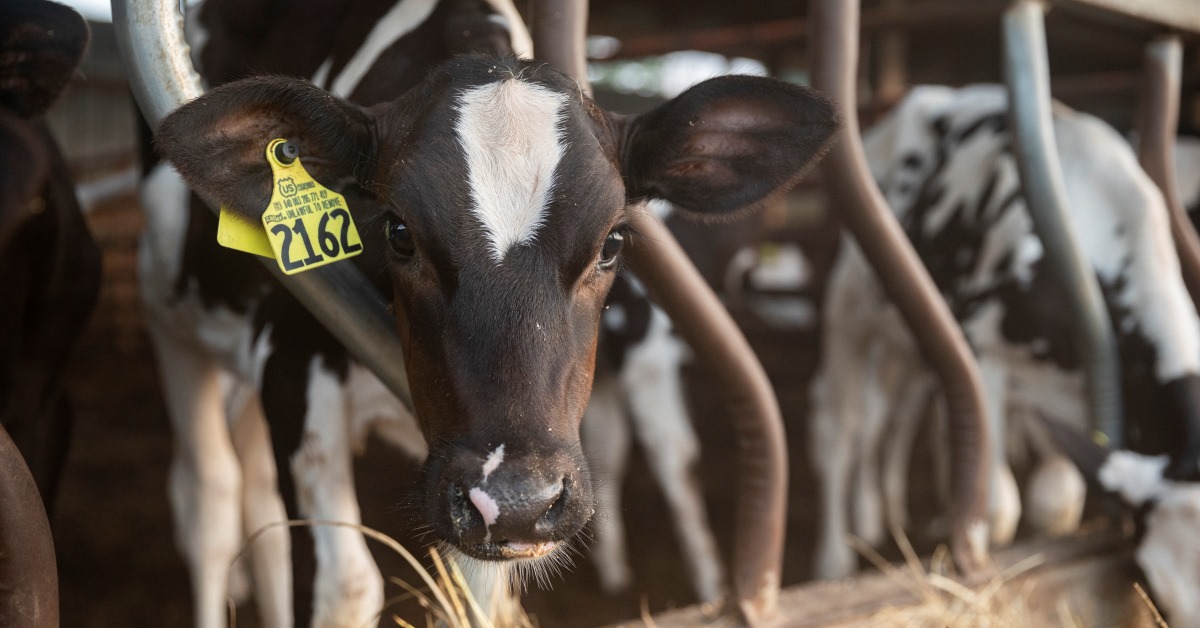
As described in Dr. Angie Golombeski’s 2017 e-newsletter on “Dairy heifer growth benchmarks,” heifers represent the future potential of a dairy operation. Raising heifers is costly and labor-intensive, so improving efficiency can no doubt have a significant impact on the overall profitability of a dairy operation.
The recommended age at first calving is between 22–24 months of age, and mature body weight plays a significant role in that metric. Heifers should be 55% of their mature body weight at breeding and 85% of their mature body weight at calving. So, for example, if your mature cow body weight averages at 1,500 pounds, then you can assume that your developing heifers should be bred at 825 pounds and should calve at 1,275 pounds. While calving heifers young can be beneficial for the dairy, it is more important to focus on developing and following strict heifer breeding criteria in order to control their age at first calving and tighten the age variance of when heifers first freshen.
To best evaluate the success of a heifer feeding program, weights and measurements should be taken routinely, either monthly or bi-monthly, to ensure that your growth and body weight goals are on track. Obtaining these measurements at critical points of development — such as birth, preweaning, postweaning/pre-puberty, breeding age and calving age — will offer information on where bottlenecks may be occurring and where you can make potential changes to improve your heifer growing program.
Hubbard Feeds has had a collaborative partnership with the University of Minnesota’s Southern Research and Outreach Center (SROC) since 2004, which has given us the ability to conduct dozens of research trials and obtain thousands of growth metrics for dairy heifer calves from birth to 6 months of age. So, how do the SROC calves measure up to industry recommendations for dairy heifer growth? Table 1 below compares the industry recommendations for 6-month-old heifers with real-time data from more than 10,000 Holstein heifers from the last 10 years at SROC.
Table 1. Industry growth recommendations vs. SROC growth data for Holstein heifers at 6 months of age.
|
|
Industry recommendations |
SROC |
|
Body weight |
369 lbs. |
431 lbs. |
|
Average daily gain |
1.7–1.8 lbs./hd/day |
1.85 lbs./hd/day |
|
Hip height |
42.0–44.5 inches |
44.7 inches |
|
Age at first calving |
22–24 months |
24 months |
As seen in Table 1, SROC calves out-performed industry recommendations across the parameters of body weight, average daily gain and hip height while also achieving each dairy herd’s goal for age at first calving. To further dissect Table 1, the large majority of SROC calves in this 10-year data set were fed a conventional milk replacer feeding program, feeding 2 quarts of milk reconstituted to 12.5% solids twice per day and weaning between 6 and 7 weeks of life. It is often suggested that a more accelerated milk feeding program must be implemented to reach industry recommendations for growth and performance, but our data further strengthens the notion that feeding a high-quality and palatable calf feed — such as Calf Krunch®, Elite 18 or Blueprint® starters — for the first 8 weeks of life sets calves up for exceptional rumen development, continued performance and optimal intake as they move through the early heifer growing phase.
If you have questions about your calf and heifer program or would like to benchmark your dairy’s heifer growing program from birth to calving, contact your local Hubbard Feeds representative.
References:
Hoffman, P. C. 2015. Optimum Growth Rates for Holstein Heifer Replacements. University of Wisconsin-Madison.
Coffeen, P. 2018. Four Misconceptions of Pre-Fresh Heifers. Progressive Dairyman.
Heinrichs, J., and B. Lammers. 1998. Monitoring Dairy Heifer Growth.
Golombeski, A. 2017. Dairy Heifer Growth Benchmarks. Hubbard Feeds.
- Log in to post comments
